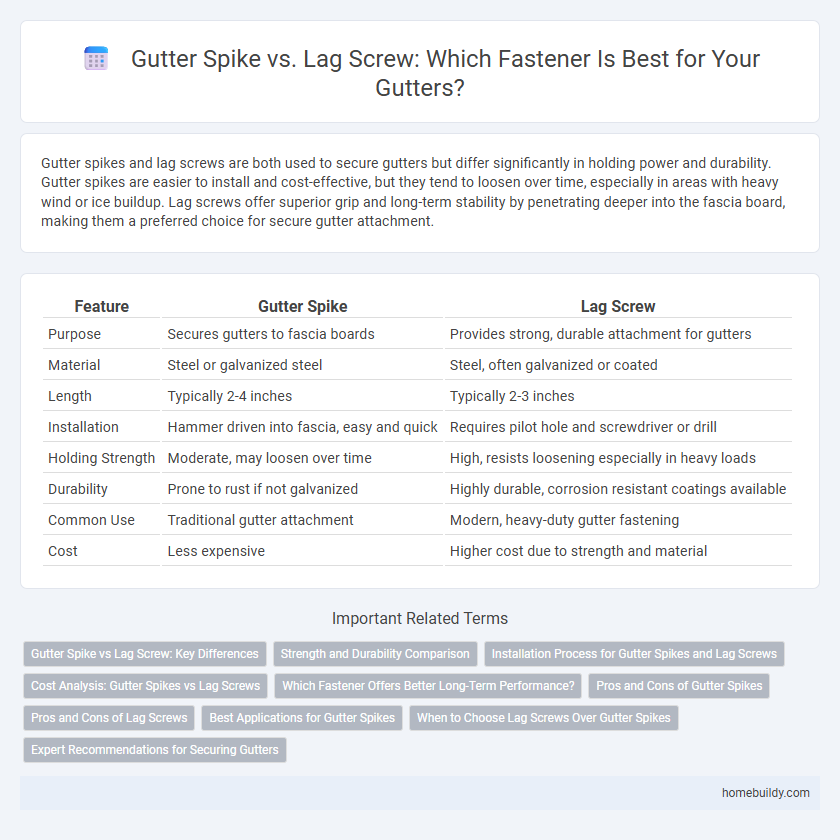Gutter spikes and lag screws are both used to secure gutters but differ significantly in holding power and durability. Gutter spikes are easier to install and cost-effective, but they tend to loosen over time, especially in areas with heavy wind or ice buildup. Lag screws offer superior grip and long-term stability by penetrating deeper into the fascia board, making them a preferred choice for secure gutter attachment.
Table of Comparison
| Feature | Gutter Spike | Lag Screw |
|---|---|---|
| Purpose | Secures gutters to fascia boards | Provides strong, durable attachment for gutters |
| Material | Steel or galvanized steel | Steel, often galvanized or coated |
| Length | Typically 2-4 inches | Typically 2-3 inches |
| Installation | Hammer driven into fascia, easy and quick | Requires pilot hole and screwdriver or drill |
| Holding Strength | Moderate, may loosen over time | High, resists loosening especially in heavy loads |
| Durability | Prone to rust if not galvanized | Highly durable, corrosion resistant coatings available |
| Common Use | Traditional gutter attachment | Modern, heavy-duty gutter fastening |
| Cost | Less expensive | Higher cost due to strength and material |
Gutter Spike vs Lag Screw: Key Differences
Gutter spikes and lag screws serve distinct purposes in securing gutters, with gutter spikes designed for quick installation and easier removal, primarily used in traditional wooden gutters. Lag screws offer stronger holding power and greater resistance to shear forces, making them ideal for heavy-duty applications and metal or vinyl gutters. The choice between gutter spikes and lag screws hinges on the gutter material, required durability, and installation method.
Strength and Durability Comparison
Gutter spikes offer moderate strength with easy installation but are prone to loosening over time, especially under heavy wind or weight stress. Lag screws provide superior durability and holding power due to their threaded design, ensuring a more secure and long-lasting attachment for gutters. For heavy-duty applications and maximum stability, lag screws outperform gutter spikes in both strength and longevity.
Installation Process for Gutter Spikes and Lag Screws
Installing gutter spikes involves driving the spike through the gutter flange and into the fascia board with a hammer, requiring precise alignment to avoid damages. Lag screws require pre-drilling pilot holes in the fascia before using a power drill to secure the screws, offering a tighter and more secure hold than spikes. The installation process for lag screws typically takes longer but results in enhanced durability and reduced risk of gutter sagging or loosening over time.
Cost Analysis: Gutter Spikes vs Lag Screws
Gutter spikes generally cost less than lag screws, with spikes averaging around $0.05 to $0.10 per piece compared to lag screws costing $0.20 to $0.50 each. The lower price of gutter spikes makes them a budget-friendly option for large-scale gutter installations, though their durability and holding power are typically inferior to lag screws. Lag screws, while more expensive, provide stronger structural support and longer-lasting performance, potentially reducing maintenance costs over time.
Which Fastener Offers Better Long-Term Performance?
Gutter spikes provide a traditional fastening method with easier installation but tend to loosen over time due to wood expansion and contraction, leading to potential gutter sagging. Lag screws offer superior long-term performance through stronger holding power and resistance to loosening, making them ideal for securing gutters in areas with frequent weather changes. The choice between gutter spikes and lag screws significantly impacts gutter stability and reduces maintenance over the lifespan of the installation.
Pros and Cons of Gutter Spikes
Gutter spikes offer a simpler and often more cost-effective method for securing gutters, with easy installation and removal advantages compared to lag screws. However, they can be less durable and provide weaker holding power, especially in high-wind conditions or heavy snow loads, potentially leading to gutter loosening over time. Lag screws provide superior strength and long-term stability but require more effort and precision during installation.
Pros and Cons of Lag Screws
Lag screws provide superior holding power in gutter installations due to their thicker threads and larger diameter, ensuring a more secure attachment to wooden fascia boards. However, lag screws can be more challenging to install, requiring pre-drilling and more effort, which might increase labor time and cost. While they offer better durability and resistance to pull-out compared to gutter spikes, lag screws may cause wood splitting if not installed correctly.
Best Applications for Gutter Spikes
Gutter spikes are best suited for securing aluminum or steel gutters to wooden fascia boards in residential construction due to their smooth shank and ease of installation. Unlike lag screws, gutter spikes allow slight movement of the gutter, accommodating expansion and contraction caused by temperature changes. Their design makes them ideal for long runs where flexibility and corrosion resistance are required to maintain gutter integrity over time.
When to Choose Lag Screws Over Gutter Spikes
Lag screws provide superior holding power and are ideal for heavy-duty gutter installations where strong resistance to wind and debris is necessary. Choose lag screws over gutter spikes when securing gutters to hardwood or dense materials that require deeper penetration and greater structural support. Lag screws also reduce the risk of loosening over time, making them suitable for areas with frequent weather fluctuations.
Expert Recommendations for Securing Gutters
Experts recommend using lag screws over gutter spikes for securing gutters due to superior holding strength and resistance to pull-out forces. Lag screws provide a durable, long-term solution by penetrating deeper into the fascia, minimizing gutter sagging and loosening caused by weather or debris weight. Properly sized lag screws, typically 2 to 3 inches in length and corrosion-resistant, ensure optimal gutter stability and longevity compared to traditional gutter spikes.
Gutter spike vs lag screw Infographic

 homebuildy.com
homebuildy.com